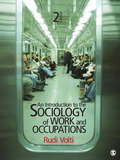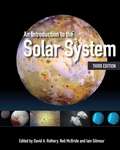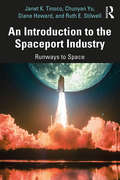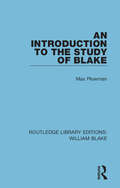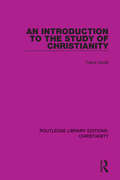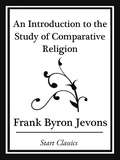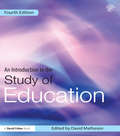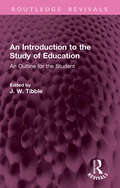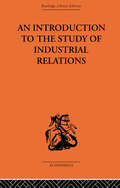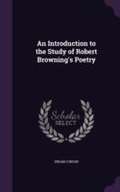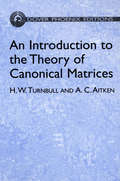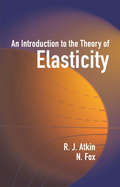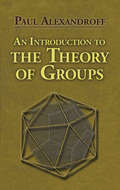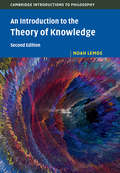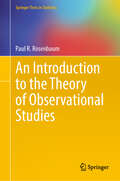- Table View
- List View
An Introduction to the Sociology of Religion: Classical and Contemporary Perspectives
by Inger Furseth Pål RepstadWhat are religion and nonreligion? How do fundamentalism and religious radicalization emerge and grow? How do social class, gender, sexuality, race, ethnicity, and other factors affect religious beliefs, practices, and organizations? Is religion a fundamental driving force or do political leaders use religion for their own purposes? In exploring these pertinent questions, An Introduction to the Sociology of Religion provides an overview of sociological theories of contemporary religious life. Theoretical discussion is accompanied by presentations of empirical research from several religious traditions in many parts of the world. The sociology of religion is linked closely to developments in general sociology. Some chapters are organized according to topic, while others offer brief presentations of classical and contemporary sociologists from Karl Marx to Patricia Hill Collins and their perspectives on social life, including on religion. This second edition has been thoroughly updated throughout with new chapters on religion and social inequalities, social and religious movements, and extremism. Covering classical sociology of religion as well as contemporary debates and topics, this book is ideal reading for students approaching the sociology of religion for the first time.
An Introduction to the Sociology of Work and Occupations (2nd Edition)
by Rudi VoltiThe Sociology of Work and Occupations, Second Edition connects work and occupations to the key subjects of sociological inquiry: social and technological change, race, ethnicity, gender, social class, education, social networks, and modes of organization. In 15 chapters, Rudi Volti succinctly but comprehensively covers the changes in the world of work, encompassing everything from gathering and hunting to working in today's Information Age. This book introduces students to a highly relevant analysis of society today. In this new and updated edition, globalization and technology are each given their own chapter and discussed in great depth.
An Introduction to the Solar System
by David A. Rothery Iain Gilmour Neil McBrideOngoing advances in Solar System exploration continue to reveal its splendour and diversity in remarkable detail. This undergraduate-level textbook presents fascinating descriptions and colour images of the bodies in the Solar System, the processes that occur upon and within them, and their origins and evolution. It highlights important concepts and techniques in boxed summaries, while questions and exercises are embedded at appropriate points throughout the text, with full solutions provided. Written and edited by a team of practising planetary scientists, this third edition has been updated to reflect our current knowledge. It is ideal for introductory courses on the subject, and is suitable for self-study. The text is supported by online resources, hosted at www.cambridge.org/solarsystem3, which include selected figures from the book, self-assessment questions and sample tutor assignments, with outlines of suggested answers.
An Introduction to the Soviet Legal System (Routledge Library Editions: Soviet Society)
by E.L. JohnsonAn Introduction to the Soviet Legal System (1969) sets the main features of modern Soviet law against their background in Russian legal history and Marxist political thought. Important constitutional provisions are examined in detail and their value in practice considered. In the second part of the book special emphasis is given to those parts of the system most likely to interest the general reader and the non-legal specialist in Soviet affairs. Criminal Procedure and Family Law are considered in detail, as are Trade Unions and the settlement of Labour Disputes. Special features of the Soviet legal system such as the legal position of the State Bank, collective farms and the state-controlled commercial and industrial enterprises are examined. The final chapter is devoted to the work of the Soviet legal profession.
An Introduction to the Spaceport Industry: Runways to Space
by Chunyan Yu Janet K. Tinoco Diane Howard Ruth E. StilwellThis book provides a contemporary look at spaceports, not only from relevant technological drivers, policies, and legal perspectives, but also from impacts associated with airspace use and aviation stakeholders. Economic, business, financial, and environmental considerations; issues facing airports transitioning to air and space ports; and spaceport planning are discussed. Through case and event studies, research and analysis, along with information obtained through professional experience, this book provides an overview of the many benefits, unique challenges, and issues facing commercial spaceports and spaceport operators. Each chapter is a standalone key topic such that the reader can focus on the most compelling issues relevant for them or can view the book as an integrated whole for a full perspective. While examples and case studies come largely from the United States, the reader can draw conclusions that are independent of country and situation. Information on other nation-state policies and advancements, among other topics, is provided to give a global perspective, further expanding the relevancy and benefits of the book to both domestic and international audiences. An Introduction to the Spaceport Industry: Runways to Space fills a gap in the literature, providing professionals, government officials, researchers, professors, and students deep insights into the fast-growing commercial spaceport industry.
An Introduction to the Standard Model of Particle Physics
by W. N. Cottingham D. A. GreenwoodThe new edition of this introductory graduate textbook provides a concise but accessible introduction to the Standard Model. It has been updated to account for the successes of the theory of strong interactions, and the observations on matter-antimatter asymmetry. It has become clear that neutrinos are not mass-less, and this book gives a coherent presentation of the phenomena and the theory that describes them. It includes an account of progress in the theory of strong interactions and of advances in neutrino physics. The book clearly develops the theoretical concepts from the electromagnetic and weak interactions of leptons and quarks to the strong interactions of quarks. Each chapter ends with problems, and hints to selected problems are provided at the end of the book. The mathematical treatments are suitable for graduates in physics, and more sophisticated mathematical ideas are developed in the text and appendices.
An Introduction to the Study of Blake (Routledge Library Editions: William Blake #5)
by Max PlowmanFirst published in 1927 (this edition in 1967), this book is about Blake, his symbols, and their meanings. As Ward says in his forward, the volume goes beyond Blake, becoming universal and timeless, and is about Religion. Plowman’s book presents itself, not as a critical text, but an interpretative one, and the study therefore illuminates the work of the author, as well as that of William Blake.
An Introduction to the Study of Christianity
by Frank DoddOriginally published in 1938, An Introduction to the Study of Christianity is a consideration of what is truly essential in the Christian faith. The book provides a detailed survey of key elements relating to the origin and growth of Christianity, and puts forward the argument that any apparent blemishes or mistakes are the result of human imperfection and misunderstanding of the real teaching of Jesus and his immediate followers, rather than of any shortcomings in the teaching itself. It first sets out the foundations of Christianity and then calls attention to the different interpretations that successive generations of Christians have placed on them. Exploring the history of the Christian faith up to the 1930s, An Introduction to the Study of Christianity will appeal to those with an interest in the history of religion, Christianity, theology, and religious studies.
An Introduction to the Study of Comparative Religion (Start Classics)
by Frank Byron JevonsThe Hartford-Lamson Lectures on The Religions of the World are delivered at Hartford Theological Seminary in connection with the Lamson Fund, which was established by a group of friends in honor of the late Charles M.Lamson, D.D., sometime President of the American Board of Commissioners for Foreign Missions, to assist in preparing students for the foreign missionary field. The Lectures are designed primarily to give to such students a good knowledge of the religious history, beliefs, and customs of the peoples among whom they expect to labor. As they are delivered by scholars of the first rank, who are authorities in their respective fields, it is expected that in pubUshed form they will prove to be of value to students generally.
An Introduction to the Study of Education
by David MathesonThis fully updated, fourth edition of An Introduction to the Study of Education provides a comprehensive and reflective introduction to the study of education, inviting students to question what education is, who it is for and what purpose it serves. Taking the reader from the early years through to lifelong learning, it examines all forms of education and learning. This new edition includes ten completely new chapters and a step-by-step guide to essay writing. There is also a companion website to accompany the book, featuring additional chapters which can be visited at www.routledge.com/cw/matheson.This fully updated, fourth edition provides: a full exploration of the historical, sociological, philosophical and psychological roots of education; a clear focus on the individual levels of education - preschool, compulsory, post-compulsory and lifelong learning; the latest debates within special educational needs; an in-depth examination of learning styles; insights into the historical development of education and the role of, and background to, research in education; a focus on current educational practice and diversity across the United Kingdom and Ireland. Written in a clear and accessible style, this is the essential core text for all beginning students on undergraduate and postgraduate courses in Education Studies and all those interested in education today, where it came from and where it is going.
An Introduction to the Study of Education
by David MathesonThis fully updated, fourth edition of An Introduction to the Study of Education provides a comprehensive and reflective introduction to the study of education, inviting students to question what education is, who it is for and what purpose it serves. Taking the reader from the early years through to lifelong learning, it examines all forms of education and learning. This new edition includes ten completely new chapters and a step-by-step guide to essay writing. There is also a companion website to accompany the book, featuring additional chapters which can be visited at www.routledge.com/cw/matheson.This fully updated, fourth edition provides: a full exploration of the historical, sociological, philosophical and psychological roots of education; a clear focus on the individual levels of education – preschool, compulsory, post-compulsory and lifelong learning; the latest debates within special educational needs; an in-depth examination of learning styles; insights into the historical development of education and the role of, and background to, research in education; a focus on current educational practice and diversity across the United Kingdom and Ireland. Written in a clear and accessible style, this is the essential core text for all beginning students on undergraduate and postgraduate courses in Education Studies and all those interested in education today, where it came from and where it is going.
An Introduction to the Study of Education: An Outline for the Student (Routledge Revivals)
by J. W. TibbleFirst Published in 1971, An Introduction to the Study of Education is a basic introduction to the curriculum of education which will be of interest to students in colleges of education as well as to sixth formers. The six contributors, all well known in the educational field, consider different aspects of the study of education. J.W. Tibble himself considers the development of the study of education. D.J. Watts contributes a chapter on educational psychology. Anne Dufton looks at the sociology of education, while its history is examined by Malcolm Seaborne and its philosophy by R.F. Dearden. The relationship between theory and practice is considered by Harold Entwistle, and a final chapter, by J.W. Tibble, looks at the curriculum courses available in Britain.
An Introduction to the Study of Experimental Medicine
by Claude BernardClear and penetrating presentation of the basic principles of scientific research from the great French physiologist whose contributions in the 19th century included the discovery of vasomotor nerves; nature of curare and other poisons in human body; functions of pancreatic juice in digestion; elucidation of glycogenic function of the liver.
An Introduction to the Study of Gothic Architecture
by John Henry ParkerThis popular and important textbook of Gothic architecture, first published in 1849, which ran to at least sixteen editions. The book is divided into the main body of the text, with mostly English examples of the various periods, and a section on foreign styles (French Gothic, Italian, Spanish, Swiss, Belgian, German).-Print ed.John Henry Parker CB (1 March 1806 – 31 January 1884) was an English archaeologist and writer on architecture and publisher.He was born in London, the son of John Parker, a merchant there. He was educated at Manor House School, Chiswick, and was apprenticed in 1821 to his uncle, the Oxford bookseller Joseph Parker (1774?–1850). He succeeded to his uncle's business in 1832, and ran the firm with great success, the most important of his publications being perhaps the series of the Oxford pocket classics.In 1836 he published his Glossary of terms used in Grecian, Roman, Italian, and Gothic architecture, which, published during the Gothic Revival in England, had considerable influence in extending the movement, and supplied valuable inspiration to young architects. In 1848 he edited the fifth edition of Thomas Rickman's Gothic architecture, and in 1849 he published a handbook based on his earlier volume entitled Introduction to the study of Gothic architecture. The completion of Hudson Turner's Domestic architecture of the Middle Ages next engaged his attention, three volumes being published (1853–60). He published Medieval architecture of Chester in 1858 and Architectural antiquities of the city of Wells in 1866.Parker was one of the chief advocates of the restoration of ecclesiastical buildings. In 1863 he and the Oxford Diocesan Architect G.E. Street revised plans for the restoration of St. Andrew's parish church, Chinnor. Parker also designed the triplet of traceried lancet windows in the chancel of St. Nicholas the Confessor, Forest Hill. His son James Parker (1832 or 1833–1912) also practiced as an architect.
An Introduction to the Study of Industrial Relations
by Dr J RichardsonThis book gives a comprehensive survey of the field of Industrial Relations, focusing on general principles and problems. Illustrations are drawn from the practices adopted in many parts of the world such as Australia, France, Germany and the USA. Contents include chapters on the following:* Personnel Management* Training* Methods of Wage Payment* Job Evaluation* Profit-Sharing and Co-partnership* Trade Unionism* Employers' Organizations* Collective Bargaining* Wage Bases* Equal Opportunities* Conciliation and Arbitration
An Introduction to the Study of Mysticism
by Richard H. Jones2022 CHOICE Outstanding Academic TitleThe purpose of this book is to fill a gap in contemporary mystical studies: an overview of the basic ways to approach mystical experiences and mysticism. It discusses the problem of definitions of “mystical experiences” and “mysticism” and advances characterizations of “mystical experiences” in terms of certain altered states of consciousness and “mysticism” in terms of encompassing ways of life centered on such experiences and states. Types of mystical experiences, enlightened states, paths, and doctrines are discussed, as is the relation of mystical experiences and mysticism to religions and cultures. The approaches of constructivism, contextualism, essentialism, and perennialism are presented. Themes in the history of the world’s major mystical traditions are set forth. Approaches to mystical phenomena in sociology, psychology, gender studies, and neuroscience are introduced. Basic philosophical issues related to whether mystical experiences are veridical and mystical claims valid, mystics’ problems of language, art, and morality are laid out. Older and newer comparative approaches in religious studies and in Christian theology are discussed, along with postmodernist objections. The intended audience is undergraduates and the general public interested in the general issues related to mysticism.
An Introduction to the Study of Social Administration (Routledge Library Editions: Social Administration & Social Policy)
by David C. MarshOriginally published in 1965, this introductory textbook provides the student with an outline of the subject matter of Social Administration. It deals with the growth of this discipline of study, its inter-relatedness with the other social sciences, and examines the historical development and structure of the social services in the 20th Century. The book discusses the complexity of the study of the study of the formation and implementation of social policy in the United Kingdom and will be of interest to those in the areas of the history of social policy and the welfare state.
An Introduction to the Theory of Canonical Matrices
by H. W. Turnbull A. C. AitkenThorough and self-contained, this penetrating study of the theory of canonical matrices presents a detailed consideration of all the theory's principal features. Topics include elementary transformations and bilinear and quadratic forms; canonical reduction of equivalent matrices; subgroups of the group of equivalent transformations; and rational and classical canonical forms. The final chapters explore several methods of canonical reduction, including those of unitary and orthogonal transformations. 1952 edition. Index. Appendix. Historical notes. Bibliographies. 275 problems.
An Introduction to the Theory of Elasticity
by R. J. Atkin N. FoxThanks to intense research activity in the field of continuum mechanics, the teaching of subjects such as elasticity theory has attained a high degree of clarity and simplicity. This introductory volume offers upper-level undergraduates a perspective based on modern developments that also takes into account the limited mathematical tools they are likely to have at their disposal. It also places special emphasis on areas that students often find difficult upon first encounter. An Introduction to the Theory of Elasticity provides an accessible guide to the subject in a form that will instill a firm foundation for more advanced study.The topics covered include a general discussion of deformation and stress, the derivation of the equations of finite elasticity with some exact solutions, and the formulation of infinitesimal elasticity with application to some two- and three-dimensional static problems and elastic waves. Answers to examples appear at the end of the book.
An Introduction to the Theory of Groups (Dover Books on Mathematics)
by Paul Alexandroff Hazel Perfect G. M. PetersenThis introductory exposition of group theory by an eminent Russian mathematician is particularly suited to undergraduates, developing material of fundamental importance in a clear and rigorous fashion. The treatment is also useful as a review for more advanced students with some background in group theory. Beginning with introductory examples of the group concept, the text advances to considerations of groups of permutations, isomorphism, cyclic subgroups, simple groups of movements, invariant subgroups, and partitioning of groups. An appendix provides elementary concepts from set theory. A wealth of simple examples, primarily geometrical, illustrate the primary concepts. Exercises at the end of each chapter provide additional reinforcement.
An Introduction to the Theory of Knowledge
by Noah LemosA clear and accessible introduction to epistemology or the theory of knowledge.
An Introduction to the Theory of Knowledge (Cambridge Introductions to Philosophy)
by Noah LemosNow revised and containing three new chapters, this book provides a clear and accessible introduction to epistemology, or the theory of knowledge. It discusses some of the main theories of justification, including foundationalism, coherentism, reliabilism, and virtue epistemology. Other topics include the Gettier problem, internalism and externalism, skepticism, the problem of epistemic circularity, a priori knowledge, naturalized epistemology, and the epistemic significance of testimony and disagreement. Intended primarily for students taking their first classes in epistemology, this lucid and well-written text will provide an excellent introduction to anyone interested in knowing more about this important area of philosophy.
An Introduction to the Theory of Linear Spaces (Dover Books on Mathematics)
by Richard A. Silverman Georgi E. ShilovThis introduction to linear algebra and functional analysis offers a clear expository treatment, viewing algebra, geometry, and analysis as parts of an integrated whole rather than separate subjects. All abstract ideas receive a high degree of motivation, and numerous examples illustrate many different fields of mathematics. Abundant problems include hints or answers.
An Introduction to the Theory of Observational Studies (Springer Texts in Statistics)
by Paul R. RosenbaumThis book is an introduction to the theory of causal inference in observational studies. An observational study draws inferences about the effects caused by treatments or preventable exposures when randomized experimentation is unethical or infeasible. An observational study is distinguished from an experiment by the problems that follow from the absence of randomized assignment of individuals to treatments. Observational studies are common in most fields that study the effects of treatments or policies on people, including public health and epidemiology, economics and public policy, medicine and clinical psychology, and criminology and empirical legal studies. After Part I reviews causal inference in randomized experiments, the twelve short chapters in Parts II, III and IV introduce modern topics: the propensity score, ignorable treatment assignment, the principal unobserved covariate, algorithms for optimal matching, randomized reassignment techniques for appraising the covariate balance achieved by matching, covariance adjustment, sensitivity analysis, design sensitivity, ways to design an observational study to be insensitive to larger unmeasured biases, the large sample efficiency of a sensitivity analysis, quasi-experimental devices that provide observable information about unmeasured biases, evidence factors and complementary analyses to address unmeasured biases. The book is accessible to anyone who has completed an undergraduate course in mathematical statistics. The subject is developed with the aid of two simple empirical examples concerning the health benefits or harms caused by consuming alcohol. The data for these examples and their reanalyses are freely available in an R package, iTOS, associated with Introduction to the Theory of Observational Studies.

